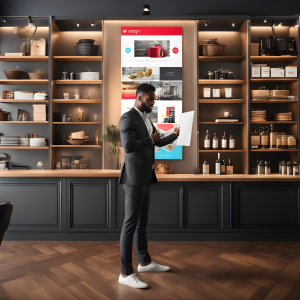The Ultimate Guide to Making Money Online: Proven Strategies for Unprecedented Success.
In today’s digital age, the internet offers unparalleled opportunities for making money online. As reported by Statista, the global e-commerce market is set to reach a staggering $3,183.16 billion by the end of 2023, growing at a compound annual growth rate (CAGR) of 12.2% from 2022.
This exponential growth presents an immense chance for anyone looking to generate income from the digital landscape. But, how can you rise above the competition and attract customers in this fiercely competitive arena?
In an era where the virtual realm teems with prospects, we embark on a journey to unveil the secrets of online prosperity. From igniting the allure of your offers to reaching the precise clientele, this guide is meticulously designed to be your trusted companion on the path to triumph.
Drawing from a wellspring of experience and knowledge, we navigate the intricacies of how to craft irresistible offers that are so compelling that customers can’t help but buy from you. We’ll teach you everything you need to know about targeting the perfect audience, supercharging your income, and ensuring you are equipped with the wisdom to thrive in this digital frontier.
Selling Smarter: The Irresistible Offer Advantage.

In the vast landscape of online commerce, where choices are abundant and attention spans fleeting, the art of crafting irresistible offers is a potent weapon in the hands of savvy entrepreneurs. But what makes an offer truly irresistible, and how does it wield its power to capture your audience? In this section, we will delve into the psychology of irresistible offers, exploring the core principles behind their effectiveness.
The Psychology of Irresistible Offers:

Imagine you’re browsing online for a product or service that you need. You come across two different offers that seem to offer the same solution. One of them is generic, vague, and boring. The other one is specific, clear, and exciting. Which one would you choose?
The answer is obvious. You would choose the one that appeals to you more, the one that speaks to your needs, wants, and emotions. The one that makes you feel like it was made just for you.
That’s the power of crafting the perfect offer. An offer that aligns with your target audience’s desires and makes them irresistible. An offer that can skyrocket your online income and success.
In this comprehensive guide, we’ll show you how to master the psychology of irresistible offers and unlock their potential for your online business.
You’ll learn how to understand and apply the psychological principles of perceived value, scarcity and urgency, emotional appeal, solving pain points, and social proof. You’ll also discover how to avoid common pitfalls that can ruin your offer and how to optimize your offer based on real-world feedback.
Understanding and Applying the Psychological Principles of Irresistible Offers:

At the heart of an irresistible offer lies a deep understanding of human psychology. It taps into our most primal desires and triggers emotions that impel us to take action. Here are some psychological principles that underpin such offers:
Perceived Value in Marketing: Making The Customer Feel That, They Are Getting More Than They Are Paying For:

Perceived value is the difference between the actual value and the perceived value of a product or service. Actual value is the objective measure of what a product or service is worth, such as its cost, quality, or features. Perceived value is the subjective measure of what a product or service is worth to a customer, based on their expectations, preferences, and emotions.
The higher the perceived value, the more likely a customer is to buy a product or service. Therefore, one of the goals of an irresistible offer is to increase the perceived value of your product or service by highlighting its benefits, advantages, and uniqueness.
For example, Groupon.com is an online platform that offers deals and discounts on various products and services. Groupon increases the perceived value of its offers by showing the original price and the discounted price of each deal, creating a contrast effect that makes customers feel like they are getting a great bargain. Groupon also shows how many people have bought each deal, creating a social proof effect that makes customers feel like they are getting a popular and valuable offer.
Scarcity and Urgency in Marketing: Creating a Sense Of Limited Availability and Time Triggers FOMO (Fear Of Missing Out):

Scarcity and urgency are psychological triggers that create a sense of pressure and anxiety in customers. Scarcity refers to the limited availability or quantity of a product or service, while urgency refers to the limited time or opportunity to buy a product or service. Both scarcity and urgency make customers feel like they might lose out on something valuable if they don’t act fast.
Fear of missing out (FOMO) is a powerful motivator that drives customers to take action. Therefore, one of the goals of an irresistible offer is to create scarcity and urgency by limiting the supply or duration of your product or service or by adding incentives or penalties for buying or not buying your product or service.
For example, Booking.com is an online platform that allows customers to book hotels and other accommodations. Booking.com creates scarcity and urgency by showing how many rooms are left at each hotel, how many people are viewing each hotel, how many people have booked each hotel in the last 24 hours, and how long each deal will last. Booking.com also shows badges such as “Deal of the day”, “Last minute deal”, or “In high demand” to emphasize the scarcity and urgency of its offers.
Emotional Appeal in Sales: Tapping into Customers’ Emotions and Making Them Feel a Certain Way:
Emotions are powerful influences on human behavior. They affect our decisions, actions, and preferences. Emotions can be positive or negative, such as happiness, sadness, anger, fear, or surprise. Emotions can also be complex or mixed, such as excitement, curiosity, nostalgia, or guilt.
Emotional appeal is a persuasive technique that uses emotions to influence customers’ attitudes and behaviors. The emotional appeal can be rational or irrational, depending on whether it is based on facts or feelings. The emotional appeal can also be direct or indirect, depending on whether it explicitly states or implies an emotion.
One of the goals of an irresistible offer is to create emotional appeal by using words, images, sounds, stories, or testimonials that evoke certain emotions in customers. The emotional appeal should match your product or service’s value proposition and your target audience’s needs and wants.
For example, Spotify is an online platform that allows customers to stream music and podcasts. Spotify creates emotional appeal by using catchy slogans, such as “Music for every mood”, “Soundtrack your life”, or “Listen to what you love”. Spotify also uses personalized playlists, such as “Your Daily Mix”, “Your Top Songs”, or “Your Time Capsule”, to evoke emotions such as happiness, nostalgia, or curiosity. Spotify also uses social features, such as “Friend Activity”, “Collaborative Playlists”, or “Share Music”, to evoke emotions such as excitement, belonging, or pride.
These principles are not mutually exclusive; they can be combined and applied in different ways depending on your product, market, and audience. The key is to understand what motivates your customers and what makes them tick.
Real-Life Success Stories in Business:
Let’s journey through the annals of online commerce and uncover real-life success stories that bear testament to the efficacy of crafting irresistible offers:
Success Story 1: Apple’s iPhone Launch

When Apple unveiled the first iPhone, it wasn’t just a product launch; it was an irresistible offer. Apple tapped into the human desire for innovation, elegance, and simplicity. By showcasing the iPhone as a revolutionary device, they created an unparalleled sense of perceived value. Coupled with the element of scarcity (only one chance to be an early adopter) and emotional appeal (the promise of a new era in technology), customers camped outside stores and lined up for hours to get their hands on this groundbreaking product.
“You’ve got to start with the customer experience and work back toward the technology – not the other way around.” – Steve Jobs.
Success Story 2: Amazon Prime

Amazon Prime is a textbook example of how to craft an irresistible offer. By offering free two-day shipping, Amazon not only simplified customers’ lives but also created a strong emotional connection. The value proposition was clear: for a modest annual fee, customers gained access to an array of benefits, including streaming services and exclusive deals. Amazon leveraged the psychology of perceived value and convenience, and it paid off handsomely. Prime members spend more on Amazon than non-Prime members, demonstrating the power of an irresistible offer.
“I love Amazon Prime. It’s so convenient and saves me a lot of money and time. I can order anything I want and get it in two days. Plus, I get access to tons of movies and shows that I can watch anytime.” – Sarah M., a satisfied Amazon Prime customer.
Success Story 3: Dropbox’s Referral Program

Dropbox, a cloud storage service, achieved explosive growth through a brilliantly crafted irresistible offer: a referral program. They offered extra storage space to users who referred friends. This tapped into the psychology of reciprocity, where people are more likely to do something for you if you’ve done something for them. The program turned Dropbox users into advocates, significantly expanding their user base.
“We just tried to make something that people wanted. And then we tried to get people who liked it to tell their friends about it.” – Drew Houston, the founder of Dropbox.
These success stories underscore the immense potential of crafting offers that resonate with the human psyche. They illustrate how businesses can create value, generate demand, increase loyalty, and achieve remarkable results by applying the principles of irresistible offers.
Crafting the Perfect Offer: A Guide to Irresistible Offers That Sell Like Crazy and Audience Alignment:

Imagine you’re browsing online for a product or service that you need. You come across two different offers that seem to offer the same solution. One of them is generic, vague, and boring. The other one is specific, clear, and exciting. Which one would you choose?
The answer is obvious. You would choose the one that appeals to you more, the one that speaks to your needs, wants, and emotions. The one that makes you feel like it was made just for you.
That’s the power of crafting the perfect offer. An offer that aligns with your target audience’s desires and makes them irresistible. An offer that can skyrocket your online income and success.
In this comprehensive guide, we’ll show you how to craft the perfect offer for your online business. You’ll learn how to understand your target audience, tailor your offer to their needs and preferences, and avoid common pitfalls that can ruin your offer. You’ll also discover the best practices and techniques to optimize your offer and make it stand out from the crowd.
Why You Need to Align Your Offer with Your Audience:
Before we delve into the mechanics of crafting the perfect offer, it’s crucial to grasp the importance of aligning your offer with your audience.
Your audience isn’t a monolithic entity; it’s a diverse spectrum of individuals with unique needs, preferences, and pain points. Crafting the perfect offer necessitates an intimate understanding of your audience’s desires, aspirations, and challenges.
Aligning your offer with your audience has many benefits, such as:
Relevance: Offers tailored to your audience’s specific needs and desires are more likely to capture their attention and interest. Generic offers often fall flat or get ignored.
Emotional Connection: An offer that directly speaks to your audience’s emotions and experiences forges a powerful connection that can influence their decision-making process. People gravitate toward offers that make them feel understood and valued.
Trust and Credibility: Aligning your offer with your audience’s expectations enhances your credibility and authority in their eyes. Trust forms the foundation of successful online transactions and relationships.
Conversion: An offer that resonates with your audience and persuades them of the value and benefits of your product or service can increase your conversion rate and sales.
How to Understand Your Target Audience for Offer Optimization:
To craft the perfect offer, you need to thoroughly research and understand your target audience. You need to know who they are, what they want, what they need, what they struggle with, and what they aspire to.
There are many ways to conduct market research and gain valuable insights into your audience, such as:
Surveys: Surveys are a great way to collect feedback and opinions from your existing or potential customers. You can use surveys to find out what topics they are interested in, what challenges they face, what goals they have, what preferences they have, etc.
You can use tools like SurveyMonkey or Google Forms to create and distribute surveys online.
Social Listening: Social listening is the process of monitoring social media platforms and forums for mentions of your brand, product, service, niche, or keywords related to your business.
You can use social listening to see what questions they ask, what opinions they share, what trends they follow, what problems they encounter, etc. You can use tools like Hootsuite or BuzzSumo to track and analyze social media conversations.
Data Analysis: Data analysis is the process of collecting and interpreting data from various sources, such as Google Analytics, Facebook Insights, email marketing platforms, etc.
You can use data analysis to see how your audience behaves on your website or landing page, such as how long they stay, what pages they visit, what actions they take, etc.
You can also use data analysis to see how your audience responds to your email campaigns or social media posts, such as how many open rates, click-through rates, shares, comments, etc.
By using these methods, you can create a detailed profile of your target audience that includes information such as:
Demographics: Age, gender, location, education level.
Psychographics: Interests.
Personality: Values, attitudes, beliefs, motivations.
Behavior: Online habits, purchase patterns, preferred channels.
Pain Points: Problems, frustrations, challenges, fears.
Goals: Desires, aspirations, needs, wants.
By understanding your target audience, you can tailor your offer to their specific needs and preferences. You can also segment your audience based on these criteria and create different offers for each segment to enhance relevance and conversion.
How to Tailor Your Offer to Your Audience’s Needs and Preferences:

Once you have a clear picture of your target audience, you can start crafting your offer. Your offer should highlight the benefits and value of your product or service and persuade your audience to take action.
There Are Many Elements That Make Up a Compelling Offer, Such As:
Headline: The headline is the first thing that your audience sees when they encounter your offer. It should capture their attention and interest and make them want to read more.
Your headline should be clear, concise, and specific. It should also include your main benefit or value proposition and a hook that appeals to your audience’s emotions or curiosity.
Sub headline: The sub headline is the second thing that your audience sees when they encounter your offer. It should complement and expand on your headline and provide more details or information.
Your sub headline should be clear, concise, and specific. It should also include a secondary benefit or value proposition and a reason why your audience should act now.
Body Copy: The body copy is the main text that explains your offer and convinces your audience to buy.
It should address your audience’s pain points, goals, and objections and show how your product or service can solve them. Your body copy should be clear, concise, and specific. It should also include features, benefits, testimonials, social proof, guarantees, and calls to action.
Visuals: Visuals are the images or videos that accompany your offer and illustrate your product or service. They should support and enhance your copy and show your audience what they can expect from your offer.
Your visuals should be clear, high-quality, and relevant. They should also include captions, labels, or annotations that explain or highlight key points.
To Tailor Your Offer To Your Audience’s Needs and Preferences, You Need To:
Use their language and tone: Use words and phrases that resonate with your audience and match their level of formality or informality. Avoid jargon or technical terms that might confuse them or make them feel alienated.
Focus on benefits rather than features: Emphasize how your product or service can help your audience achieve their goals or overcome their challenges rather than listing its features or specifications.
Show them the transformation or outcome they can expect from your offer rather than the process or mechanism.
Address their objections or concerns: Anticipate any questions or doubts that your audience might have about your offer and provide answers or solutions.
Use testimonials, social proof, guarantees, or risk reversals to build trust and credibility.
Create urgency or scarcity: Motivate your audience to act fast by creating a sense of urgency or scarcity.
Use deadlines, countdown timers, limited quantities, or exclusive bonuses to make them feel like they might miss out on a great opportunity if they don’t act now.
How to Avoid Common Pitfalls That Can Ruin Your Offer:
Even if you have a great product or service and a deep understanding of your target audience, you might still make some mistakes that can ruin your offer and hurt your conversion rate. Here are some common pitfalls to avoid when crafting your offer:
Being too vague or generic: Avoid using vague or generic statements that don’t convey any value or benefit to your audience. For example, don’t say “We offer the best solution for your problem” or “We have everything you need”.
Instead, say “We help you save 50% on your energy bills” or “We have over 1000 courses on any topic you can imagine”.
Being too complicated or confusing: Avoid using complicated or confusing words or phrases that might make it hard for your audience to understand what you are offering or what they need to do.
For example, don’t say “Our proprietary algorithm optimizes the performance of our software” or “To access our platform, you need to fill out this form”. Instead, say “Our software works faster and smoother than any other” or “To get started, just enter your email address”.
Being too boring or bland: Avoid using boring or bland words or phrases that might make it hard for your audience to get excited about your offer. For example, don’t say “We have a new product for you” or “We have a special offer for you”. Instead
Being too pushy or salesy: Avoid using pushy or salesy words or phrases that might make your audience feel pressured or manipulated.
For example, don’t say “Buy now or regret later” or “This is a once-in-a-lifetime opportunity”. Instead, say “Don’t miss this chance to save money and time” or “This is a limited-time offer that you won’t find anywhere else”.
Being too long or short: Avoid making your offer too long or too short for your audience’s attention span and interest level. For example, don’t write a 10-page sales letter for a low-ticket item or a one-sentence description for a high-ticket item. Instead, write enough to cover the essential points and benefits of your offer and leave some room for curiosity and questions.
How to Optimize Your Offer and Make It Stand Out:
Now that you have crafted your offer and avoided the common pitfalls, you can optimize your offer and make it stand out from the crowd. Here are some tips and techniques to optimize your offer:
Use A/B Testing: A/B testing is the process of comparing two versions of your offer to see which one performs better.
You can use A/B testing to test different elements of your offer, such as headlines, sub headlines, body copy, visuals, colors, fonts, etc. You can use tools like Optimizely or Google Optimize to run A/B tests on your website or landing page.
Use Copywriting Formulas: Copywriting formulas are proven templates or structures that help you write persuasive and effective copy for your offer.
You can use copywriting formulas to guide you through the process of crafting your offer and ensure that you include all the necessary components. Some of the most popular copywriting formulas are:
AIDA: Attention, Interest, Desire, Action. This formula helps you capture your audience’s attention, spark their interest, arouse their desire, and prompt them to take action.
PAS: Problem, Agitate, Solve. This formula helps you identify your audience’s problem, agitate it by emphasizing its negative consequences, and solve it by presenting your offer as the best solution.
FAB: Features, Advantages, Benefits. This formula helps you explain what your product or service does, how it helps your audience, and why they should care.
Use Power Words: Power words are words that trigger an emotional response in your audience and make them more likely to take action.
You can use power words to make your offer more compelling and persuasive. Some of the most common power words are:
You: You is the most powerful word in marketing because it makes your offer more personal and relevant to your audience.
Free: Free is one of the most enticing words in marketing because it implies no risk or cost for your audience.
New: New is one of the most appealing words in marketing because it implies innovation and novelty for your audience.
Guaranteed: Guaranteed is one of the most reassuring words in marketing because it implies confidence and security for your audience.
Now: Now is one of the most urgent words in marketing because it implies immediacy and action for your audience.
Crafting the perfect offer is a skill that can help you increase your online income and success. By aligning your offer with your target audience’s needs and preferences, you can create an irresistible offer that converts.
To craft the perfect offer, you need to understand your target audience, tailor your offer to their needs and preferences, avoid common pitfalls that can ruin your offer, and optimize your offer and make it stand out.
By following these steps, you can craft the perfect offers that sell like crazy for your online business and achieve your online goals. You will also significantly increase your chances of converting potential customers into loyal patrons.
As we journey through this guide, keep in mind that precision in targeting is the key to maximizing your online earning.
Unlocking Profit Potential: Mastering Premium Pricing Strategies:

Have you ever wondered how Apple can charge $1,000 for an iPhone, while other smartphones sell for half the price or less? How do luxury brands like Rolex, Chanel, or Ferrari command such high prices for their products? And how can you apply the same principles to your own online business and make more money from your products or services?
The answer lies in a powerful strategy known as Premium Pricing. In this comprehensive guide, we’ll show you how to master premium pricing and unlock its profit potential for your online business.
You’ll learn what premium pricing is, how it works, and why it’s so effective. You’ll also discover the best premium pricing strategies to implement in your online business, and the benefits you can expect from them.
What Is Premium Pricing? At its core, Premium Pricing is the strategic practice of setting higher prices for products or services compared to similar offerings in the market.
It’s a calculated choice that positions a business as a provider of Exceptional Quality, Exclusivity, and Value-Added Services.
Premium pricing can increase your profit margins, improve your brand perception and value, and attract loyal customers who are willing to pay more for your products or services.
According to a study by McKinsey & Company, premium pricing can boost your revenue by 5% to 15%, and your operating profit by 20% to 50%. The study also found that customers who buy premium products or services are more likely to be satisfied, loyal, and willing to recommend your brand to others.
How Does Premium Pricing Work?
Premium pricing works by leveraging the psychology of value perception. Customers often associate higher prices with higher quality, superior craftsmanship, and an enhanced overall experience. Premium pricing leverages this perception to its advantage.
By setting higher prices than your competitors, you create a contrast effect that makes your products or services stand out as more valuable and desirable.
You also signal to your customers that you are confident in your quality and value proposition, and that you are not competing on price alone.
Premium pricing also appeals to customers’ emotions and aspirations. Customers who buy premium products or services feel more confident, successful, and satisfied.
They also feel a sense of exclusivity and belonging to a select group of people who can afford and appreciate your products or services.
What Are the Benefits of Premium Pricing?
Premium pricing can offer many benefits for your online business, such as:
- Increased Profit Margins: By charging more for your products or services, you can increase your profit margins and generate more revenue. You can also invest more in improving your quality, innovation, and customer service.
- Improved Brand Perception and Value: By setting higher prices, you can enhance your brand perception and value in the eyes of your customers. You can also differentiate yourself from your competitors and establish yourself as a leader in your niche.
- Attracted Loyal Customers: By offering exceptional quality, exclusivity, and value-added services, you can attract loyal customers who are willing to pay more for your products or services. You can also reduce customer churn and increase customer lifetime value.
- Reduced Price Sensitivity: By focusing on value rather than price, you can reduce price sensitivity among your customers. You can also avoid price wars with your competitors and maintain your premium positioning.
How to Master Premium Pricing Strategies for Your Online Business:
Now that you know what premium pricing is, how it works, and why it’s so effective, let’s look at some of the best premium pricing strategies to implement in your online business. These strategies are:
- Delivering Exceptional Quality
- Building Brand Reputation
- Crafting Exclusivity
- Offering Value-Added Services
Let’s explore each of these strategies in detail.
How companies can get smart about raising prices:
Delivering Exceptional Quality: One of the most fundamental aspects of premium pricing is delivering Exceptional Quality. Your product or service should genuinely outshine the competition in terms of craftsmanship, materials, or features.
For example, Apple is known for its exceptional quality in design, performance, and user experience. Its products are made with premium materials, such as glass, aluminum, or stainless steel. They also offer innovative features, such as Face ID, Air Pods, or Apple Pay.
These factors justify Apple’s premium pricing and make customers willing to pay more for its products.
To deliver exceptional quality, you need to:
- Focus on your core value proposition and what makes your product or service unique and superior.
- Invest in research and development to create innovative solutions that solve your customers’ problems and needs.
- Use high-quality materials and components that ensure durability and reliability.
- Implement rigorous quality control and testing processes to ensure consistency and excellence.
Provide a seamless and intuitive user experience that delights your customers.
Building Brand Reputation: Crafting a strong Brand Reputation is crucial for premium pricing. Customers must associate your brand with trust, reliability, and a history of delivering excellence.
For example, Rolex is a brand that has built a reputation for excellence over decades. Its watches are synonymous with precision, durability, and luxury.
Rolex also invests heavily in marketing and sponsorship to maintain its image and prestige. These factors make Rolex a premium brand that customers aspire to own.
To build a brand reputation, you need to:
Define your brand identity and values and communicate them clearly and consistently.
Create a compelling brand story that connects with your customers’ emotions and aspirations.
Showcase your expertise and authority in your niche by providing valuable content and resources.
Engage with your customers and build relationships through social media, email marketing, or online communities.
Encourage customer feedback and testimonials and showcase them on your website or social media platforms.
Crafting Exclusivity: Creating a sense of Exclusivity can be a potent strategy for premium pricing. Limited editions, exclusive access, or membership programs can all contribute to the perception of exclusivity.
For example, Ferrari is a brand that creates exclusivity by limiting the production and availability of its cars. Its customers have to wait for months or even years to get their hands on a Ferrari.
Ferrari also offers exclusive access to events, clubs, or services for its loyal customers. These factors make Ferrari a highly desirable and exclusive brand that customers are willing to pay a premium for.
To craft exclusivity, you need to:
- Limit the supply or availability of your product or service to create scarcity and demand.
- Offer special editions or variations of your product or service that are only available for a limited time or quantity.
- Create a membership program or a loyalty program that rewards your customers with exclusive benefits or perks.
- Host exclusive events or webinars that provide valuable information or entertainment for your customers.
- Partner with other premium brands or influencers that share your target audience and values.
Offering Value-Added Services or support can justify higher prices for your product or service. This might include personalized customer support, extended warranties, or added convenience.
For example, Shopify is an e-commerce platform that charges more than its competitors, but offers more value-added services for its customers. Shopify provides 24/7 customer support, unlimited bandwidth and storage, free SSL certificates, and hundreds of integrations and apps.
Shopify also offers convenience and ease of use for its customers who can create and manage their online stores without any coding or technical skills. These factors make Shopify a premium platform that customers are happy to pay more for.
To offer value-added services, you need to:
- Understand your customers’ pain points and expectations and provide solutions that address them.
- Provide personalized customer support that is responsive, friendly, and helpful.
- Offer extended warranties or guarantees that assure your customers of your quality and reliability.
- Add convenience or flexibility to your product or service delivery, such as free shipping, fast delivery, easy returns, or multiple payment options.
- Provide additional features or benefits that enhance your product or service value, such as bonuses, discounts, free trials, or complementary products or services.
Premium pricing is a powerful strategy that can help you increase your profit margins, improve your brand perception and value, and attract loyal customers who are willing to pay more for your products or services.
To master premium pricing strategies for your online business, you need to deliver exceptional quality, build brand reputation, craft exclusivity, and offer value-added services.
By implementing these strategies, you can position yourself as a premium provider in your niche and stand out from the competition.
How to Charge Premium Prices by Reverse Engineering Value:

If you want to succeed in the competitive landscape of online money-making, you need to master one crucial skill: reverse engineering value. This is the process of dissecting your offerings to understand and communicate the value they bring to your customers. By doing so, you can justify charging premium prices and stand out from the crowd.
In this article, we’ll explain what reverse engineering value is, why it’s important, and how you can master it in seven simple steps.
What is Reverse Engineering Value?
Reverse engineering value is the art of deconstructing your products or services, highlighting their unique qualities, and then effectively conveying these attributes to your target audience.
It involves analyzing every aspect of your offering that contributes to its value, such as its features, benefits, impact, and differentiation. Then, it involves crafting compelling messaging and marketing materials that showcase these aspects and persuade customers to pay more.
Why Reverse Engineering Value?
There are many benefits of reverse engineering value for your online business. Here are some of the main ones:
- Justifying Higher Prices: Charging premium prices requires a clear justification. You can’t simply ask for more money without providing a reason. Reverse engineering value allows you to demonstrate why your offering is worth the premium, thereby convincing customers to pay more.
- Enhancing Customer Perceptions: By explicitly showcasing the value your product or service delivers, you enhance the way customers perceive it. They no longer see it as a cost but as an investment in something valuable. This increases their satisfaction and loyalty.
- Competitive Advantage: In a crowded market, value-driven pricing can give you a significant edge. It helps you stand out and compete on factors other than price. It also attracts customers who are looking for quality and value over cheapness.
How to Master Reverse Engineering Value in 7 Steps:
Now that you know what reverse engineering value is and why it’s important, let’s see how you can master it in seven simple steps:
Step 1: Thoroughly Understand Your Offering:
The first step is to gain an in-depth understanding of your product or service. What are its unique features? What problems does it solve? How does it make your customers’ lives better? List down every aspect that contributes to its value.
For example, if you’re selling a course on how to start an online business, some of the aspects that add value to your offering are:
- The content quality and depth
- The instructor’s expertise and credentials
- The learning outcomes and benefits
- The support and feedback system
- The bonuses and extras
Step 2: Identify Customer Pain Points:
The next step is to identify your customers’ pain points. What challenges do they face, and how does your offering alleviate those issues? Make a clear connection between your solution and their needs.
For example, if you’re selling a course on how to start an online business, some of the pain points your customers might have are:
- Lack of knowledge and skills
- Fear of failure and uncertainty
- Lack of time and money
- Lack of guidance and support
- Lack of motivation and accountability
Step 3: Quantify Benefits:
The third step is to translate the features and attributes of your offering into tangible benefits. For example, if you’re selling a course on how to start an online business, don’t just list its features; explain how it saves customers hours each day, helps them earn more money, or gives them more freedom and flexibility.
Step 4: Provide Proof:
The fourth step is to back your claims with evidence. Customer testimonials, case studies, and data-driven results are potent tools for demonstrating the real-world value your offering delivers. They also help you build trust and credibility with your audience.
For example, if you’re selling a course on how to start an online business, you can use testimonials from previous students who have successfully launched their businesses, case studies of how they achieved their goals, and data on how much they increased their income or reduced their workload.
Step 5: Craft Compelling Messaging
The fifth step is to use compelling language and storytelling techniques to convey the value proposition. Create marketing materials, website copy, and sales pitches that highlight the benefits and impact of your product or service. Use emotional triggers, urgency, scarcity, social proof, and other persuasion tactics to motivate customers to take action.
For example, if you’re selling a course on how to start an online business, you can use phrases like:
- “Learn how to start a profitable online business in just 30 days”
- “Join over 10,000 students who have transformed their lives with this course”
- “Don’t miss this limited-time offer: enroll today and get 50% off plus these amazing bonuses”
Step 6: Educate Your Audience:
The sixth step is to educate your audience about the value they receive. Offer webinars, tutorials, or informative content that showcases how to make the most of your offering. Explain how it works, what it includes, and what results they can expect. Answer any questions or objections they might have.
For example, if you’re selling a course on how to start an online business, you can offer a free webinar that covers:
- The benefits of starting an online business
- The common mistakes and myths about online business
- The proven framework for launching a successful online business
- The details of your course and what it offers
- A special discount and bonus for webinar attendees
Step 7: Test and Iterate:
The final step is to continuously test your messaging and value communication strategies. Collect feedback from customers and refine your approach to maximize its effectiveness. Experiment with different headlines, images, formats, channels, and audiences. Measure the results and optimize accordingly.
Now that you know how to reverse engineer value for your online products or services, you might be wondering how to increase the demand and desire for them.
How can you make your customers act fast and buy from you before they change their mind or go elsewhere? The answer lies in using three powerful psychological triggers: scarcity, urgency, and guarantees. In this section, we’ll show you how to use these triggers to boost your conversions and sales.
How to Ignite Desire and Drive Action with Scarcity, Urgency, and Guarantees:
Do you want to skyrocket your online money-making success? If so, you need to master the art of triggering desire among your potential customers. By using three powerful psychological triggers – scarcity, urgency, and guarantees – you can create a compelling and irresistible allure that drives them to take action.
In this article, we’ll explain what these triggers are, why they work, and how you can implement them effectively in your marketing.
What is Scarcity and Why Does It Work?
Scarcity is a psychological principle that suggests people value things more when they perceive them as rare or in limited supply. Scarcity creates a sense of fear of missing out (FOMO), which motivates people to act quickly before they lose the opportunity.
Scarcity works because it taps into two fundamental human biases:
- Loss aversion: People tend to prefer avoiding losses over acquiring gains. Losing something feels worse than gaining something of equal value.
- Social proof: People tend to follow the behavior of others, especially when they are uncertain or in doubt. If something is scarce, it implies that it is popular and in high demand.
How to Use Scarcity Effectively:
Here are some ways to use scarcity effectively in your online business:
1. Limited Product Availability:
One of the simplest ways to create scarcity is to highlight the limited quantity of a product or service. This creates a sense of urgency and exclusivity, as well as a perception of high quality and value.
For example, you can use phrases like “Only 10 left in stock!” or “Limited edition!” to convey scarcity. You can also use visual elements like countdown timers or progress bars on your website to show when a special offer or deal will expire.
2. Exclusive Access:
Another way to create scarcity is to offer a product or service to a select group of customers first. This creates a sense of exclusivity and privilege, as well as a desire to belong and be part of something special.
For example, you can offer early access or discounts to loyal customers as a reward for their commitment. You can also create a waiting list or a membership program that requires an invitation or an application to join.
What is Urgency and Why Does It Work?
Urgency is a psychological trigger that compels people to act quickly. It creates a sense of pressure and anxiety, as well as a fear of missing out on a valuable opportunity. Urgency works because it taps into two fundamental human biases:
- Hyperbolic discounting: People tend to prefer immediate rewards over delayed ones, even if the delayed ones are larger or better. The longer they have to wait, the less they value the reward.
- Action bias: People tend to prefer taking action over inaction, especially when they face uncertainty or ambiguity. Taking action gives them a sense of control and satisfaction.
How to Use Urgency Effectively:
Here are some ways to use urgency effectively in your online business:
1. Limited-Time Offers:
One of the most common ways to create urgency is to offer a promotion or a discount that is time-sensitive. This creates a sense of scarcity and exclusivity, as well as a fear of losing out on a great deal.
For example, you can use phrases like “Act Now,” “Last Chance,” or “Offer Expires Soon” to convey urgency. You can also use visual elements like countdown timers or banners on your website to show when the offer will end.
2. Flash Sales:
Another way to create urgency is to surprise your audience with flash sales that last for a short duration, such as a few hours or a day. This creates excitement and curiosity, as well as a desire to act fast before the sale is over.
For example, you can use phrases like “Flash Sale,” “Today Only,” or “Limited Time” to announce your flash sale. You can also use email marketing or social media to notify your subscribers and followers about your flash sale.
What are Guarantees and Why Do They Work?
Guarantees are assurances that reduce the perceived risk associated with a purchase. They build trust and confidence in your product or service, as well as eliminate any doubts or objections that your potential customers might have. Guarantees work because they tap into two fundamental human biases:
- Risk aversion: People tend to avoid taking risks, especially when they involve losing money or time. They prefer options that are safe and certain over those that are risky and uncertain.
- Reciprocity: People tend to feel obliged to return favors or kindnesses that they receive from others. They appreciate gestures that show generosity and goodwill.
How to Use Guarantees Effectively:
Here are some ways to use guarantees effectively in your online business:
1. Money-Back Guarantees:
One of the most popular types of guarantees is the money-back guarantee, which offers a full or partial refund if the customer is not satisfied with the product or service within a certain timeframe. This shows that you stand behind your product or service and that you value customer satisfaction.
For example, you can offer a no-questions-asked money-back guarantee within 30 days, 60 days, or even a year. You can also clearly outline your return or refund policy on your website to reassure customers.
2. Satisfaction Guarantees:
Another type of guarantee is the satisfaction guarantee, which promises that the customer will be happy with the product or service or receive some form of compensation, such as a replacement, an exchange, or a credit. This shows that you care about customer satisfaction and that you are committed to quality.
For example, you can use language that emphasizes customer satisfaction and quality, such as “100% Satisfaction Guaranteed” or “We Guarantee Your Happiness”. You can also showcase customer testimonials and success stories on your website to reinforce the credibility of your guarantee.
How to Skyrocket Your Online Sales with Niche-Specific Offers That Resonate:

Do you want to skyrocket your online money-making success? If so, you need to master the art of creating offers that resonate with specific audience segments. One-size-fits-all offers often fall short in capturing the attention and loyalty of diverse customer groups. That’s where crafting niche-specific offers comes into play, empowering you to dominate your niche and stand out in a crowded digital marketplace.
In this article, you’ll learn:
- What niche-specific offers are and why they are powerful
- How to conduct audience research to identify and understand your niche market
- How to tailor your product or service offerings to match the needs and preferences of your niche customers
- How to position and promote your niche-specific offers effectively
By the end of this article, you’ll be able to create offers that resonate with your target customers and skyrocket your online sales.
What are Niche-Specific Offers?
Niche-specific offers are products or services that are precisely tuned to address the unique needs, preferences, and pain points of a specific audience segment within a larger market. For example, if you are selling fitness courses online, you can create niche-specific offers for different groups of customers, such as:
- Busy professionals who want to stay fit with minimal time and equipment
- Women who want to lose weight and tone their bodies after pregnancy
- Seniors who want to improve their mobility and prevent injuries
By creating niche-specific offers, you can tailor your products or services to the specific desires and challenges of your target customers, making them feel that your offer was designed just for them.
Why are Niche-Specific Offers Powerful?
Niche-specific offers have many benefits for your online business. Here are some of the main ones:
- Pinpointed Relevance: By aligning your offer closely with the needs and preferences of your niche audience, you increase its relevance and appeal. Your potential customers will feel that you understand their world and that you have the perfect solution for them.
- Reduced Competition: By targeting a niche market, you often face less competition compared to broader markets. This means that you have a higher chance of establishing yourself as a go-to solution provider within your niche.
- Enhanced Trust and Authority: By creating offers that match the desires and challenges of your niche audience, you position yourself as an expert who knows their world inside out. This builds trust and authority, making it easier for customers to choose your offers over others.
How to Conduct Audience Research to Identify and Understand Your Niche Market:
The first step in creating niche-specific offers is to conduct thorough audience research to identify and understand your niche market. You need to clearly define the niche market you want to target and create detailed customer personas within that niche. Consider factors like:
- Demographics: Age, gender, location, income, education, etc.
- Interests: Hobbies, passions, goals, values, etc.
- Pain Points: Problems, frustrations, challenges, fears, etc.
- Purchasing Behavior: Buying habits, preferences, motivations, objections, etc.
You can use various methods and tools to conduct audience research, such as:
- Surveys and interviews: Ask your existing or potential customers directly about their needs and preferences. You can use tools like SurveyMonkey or Typeform to create and distribute online surveys.
- Online forums and communities: Observe and participate in discussions related to your niche on platforms like Reddit, Quora, or [Facebook Groups]. You can learn a lot about your niche audience’s questions, opinions, and feedback by reading their posts and comments.
- Keyword research: Use tools like Semrush or Ahrefs to find out what keywords your niche audience is searching for online. You can discover their search intent, their level of awareness, and their common problems and solutions.
- Competitor analysis: Study what your competitors are offering and how they are positioning themselves in the niche. You can use tools like SimilarWeb or SpyFu to analyze their website traffic, keywords, ads, and backlinks.
By conducting audience research, you can gain valuable insights into your niche market and create customer personas that represent your ideal buyers.
Customer personas are fictional profiles that describe the characteristics, goals, pain points, and motivations of your target customers. They help you empathize with your customers and create offers that resonate with them.
Here is an example of a customer persona for a fitness course aimed at busy professionals:
Name: John Smith Age: 35 Gender: Male Location: New York City Income: $100K/year Education: MBA Occupation: Marketing Manager Interests: Traveling, reading, sports Goals: To stay fit and healthy, to advance his career, to have more time for his family and hobbies
Pain Points: He has a hectic schedule and often works late, he struggles to find time and motivation to exercise, he feels stressed and tired, he worries about his health and weight Purchasing Behavior: He prefers online courses that he can access anytime and anywhere, he looks for credible and experienced instructors, he values convenience and flexibility, he is willing to pay for quality and results
How to Tailor Your Product or Service Offerings to Match the Needs and Preferences of Your Niche Customers:
The next step in creating niche-specific offers is to tailor your product or service offerings to match the needs and preferences of your niche customers. You need to create offers that solve their specific problems, fulfill their specific desires, and overcome their specific objections.
There are different ways to tailor your product or service offerings, depending on your business model and niche. Here are some examples:
- Product Customization: If feasible, offer variations of your product or service that cater to the specific requirements of your niche customers. For example, if you are selling fitness courses online, you can offer different courses for different fitness levels, goals, or preferences. You can also allow your customers to customize their own courses by choosing the duration, intensity, frequency, or style of the workouts.
- Bundling: Create bundles that include complementary products or services that enhance the value and convenience of your offer. For example, if you are selling fitness courses online, you can bundle them with other products or services that your niche customers might need or want, such as nutrition plans, supplements, equipment, coaching, etc.
- Pricing: Adjust your pricing strategy to suit the budget and expectations of your niche customers. For example, if you are selling fitness courses online, you can offer different pricing options for different customer segments, such as monthly subscriptions, one-time payments, discounts, trials, etc. You can also use pricing psychology techniques to influence your customers’ perception of value and urgency, such as scarcity, anchoring, contrast, etc.
- Guarantee: Provide a strong and clear guarantee that reduces the risk and increases the confidence of your niche customers. For example, if you are selling fitness courses online, you can offer a money-back guarantee if your customers are not satisfied with the results within a certain period of time. You can also offer testimonials, reviews, ratings, or social proof to back up your guarantee and credibility.
By tailoring your product or service offerings to match the needs and preferences of your niche customers, you can create offers that resonate with them and persuade them to buy from you.
How to Position and Promote Your Niche-Specific Offers Effectively:

The final step in creating niche-specific offers is to position and promote them effectively to reach and attract your niche customers. You need to communicate the value and benefits of your offers clearly and convincingly and use the right channels and strategies to deliver your message.
Here are some tips to position and promote your niche-specific offers effectively:
- Copywriting: Use persuasive and engaging copywriting techniques to craft headlines, subheadings, bullet points, calls to action, etc. that capture the attention and interest of your niche customers. Use words and phrases that resonate with their emotions, desires, fears, and aspirations. Highlight the unique selling proposition (USP) of your offer and how it differs from other alternatives in the market.
- Content Marketing: Create valuable and relevant content that educates, entertains, or inspires your niche customers and showcases your expertise and authority. Use content formats that suit your niche audience’s preferences and consumption habits, such as blog posts, videos, podcasts, ebooks, webinars, etc. Use keywords and topics that match your niche audience’s search intent and questions.
- Social Media Marketing: Use social media platforms that are popular among your niche audience to connect and interact with them. Share your content, offers, stories, tips, etc. on social media channels that suit your niche market’s characteristics and goals. For example:
- If you are selling fitness courses online for busy professionals who want to stay fit with minimal time and equipment
- You can use [LinkedIn] to reach professionals who are interested in career advancement and personal development
- You can use [Instagram] to showcase visual results and testimonials of your customers
- You can use [YouTube] to demonstrate short and effective workouts that can be done anywhere
- If you are selling fitness courses online for busy professionals who want to stay fit with minimal time and equipment
- Email Marketing: Use email marketing to build a relationship with your niche customers and nurture them through the buyer’s journey. Send them personalized and segmented emails that address their specific needs and preferences. Provide them with valuable information, tips, resources, etc. that help them solve their problems or achieve their goals. Send them timely and relevant offers that persuade them to take action.
By positioning and promoting your niche-specific offers effectively using these tips (and more), you can reach and attract more qualified leads who are ready to buy from you.
Conclusion:
Creating niche-specific offers is a powerful way to skyrocket your online sales by resonating with specific audience segments within a larger market. By following these steps:
- Conducting audience research
- Tailoring product or service offerings
- Positioning and promoting offers effectively
You can create offers that solve the unique problems, fulfill the unique desires, and overcome the unique objections of your niche customers.
This is just one article out of many coming your way. Enjoyed this? Expect more!
Related Articles















